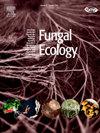角藻科病原菌生产杂醇醇和杂醇酸酯
IF 2.2
3区 环境科学与生态学
Q3 ECOLOGY
引用次数: 0
摘要
角鼻虫科包括经济上重要的植物病原体,它们在寄主偏好和生活方式上各不相同。这些真菌被认为是吸引昆虫媒介,因为它们通过它们的花香和果香传播。本研究旨在利用气相色谱-质谱联用技术鉴定角藻科真菌的挥发物。该科大多数属产生的主要挥发物为杂醇酸酯和杂醇酸酯,但其排放率在属间和同一种的分离株间差异显著。从cynaroides中收集的albifceratocystis与从Terminalia sericea中分离的菌株相比,产生了更高的fusel acetate水平。此外,在不同温度下生长的菌株在挥发性生物合成方面存在显著差异。本研究结果表明,角鼻苔科植物具有不同的挥发性特征,但需要进一步研究这种可塑性的生态和生理机制。本文章由计算机程序翻译,如有差异,请以英文原文为准。
Production of fusel alcohols and fusel acetates by pathogenic fungi in the Ceratocystidaceae
The family Ceratocystidaceae includes economically important plant pathogens that vary in host preference and lifestyle. These fungi are believed to attract insect vectors, for their dispersal through their floral and fruity scents. This study aimed to identify the volatiles produced by a subset of fungi within the Ceratocystidaceae using gas chromatography coupled with mass spectrometry. The primary volatiles produced by most genera in the family were fusel alcohols and fusel acetates, but their emission rates differed significantly between genera and isolates from a single species. Ceratocystis albifundus collected from Protea cynaroides produced higher levels of fusel acetates compared to isolates from Terminalia sericea. In addition, significant differences in volatile biosynthesis were observed between isolates grown under different temperatures. Results of this study demonstrate that Ceratocystidaceae exhibit varied volatile profiles, but further research is needed to understand the ecological and physiological mechanisms underlying this plasticity.
求助全文
通过发布文献求助,成功后即可免费获取论文全文。
去求助
来源期刊

Fungal Ecology
环境科学-生态学
CiteScore
5.80
自引率
3.40%
发文量
51
审稿时长
3 months
期刊介绍:
Fungal Ecology publishes investigations into all aspects of fungal ecology, including the following (not exclusive): population dynamics; adaptation; evolution; role in ecosystem functioning, nutrient cycling, decomposition, carbon allocation; ecophysiology; intra- and inter-specific mycelial interactions, fungus-plant (pathogens, mycorrhizas, lichens, endophytes), fungus-invertebrate and fungus-microbe interaction; genomics and (evolutionary) genetics; conservation and biodiversity; remote sensing; bioremediation and biodegradation; quantitative and computational aspects - modelling, indicators, complexity, informatics. The usual prerequisites for publication will be originality, clarity, and significance as relevant to a better understanding of the ecology of fungi.
 求助内容:
求助内容: 应助结果提醒方式:
应助结果提醒方式:


